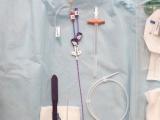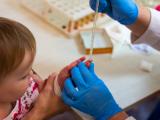Jan 21, 2010 (CIDRAP News) A multi-national team of researchers has applied a new genomic tool to a 50-year-old bacterial foe, using minute mutations to track the spread of drug-resistant staph both across continents and within a single hospital.
On a global scale, their sleuthing tracked the movement of one clone of methicillin-resistant Staphylococcus aureus (MRSA) back and forth across the planet, pinpointing when individual cases transported infections across national borders to spark new outbreaks. Separately, their method demonstrated that what appeared to be a hospital epidemic of MRSA was not a single outbreak, but rather a mixed event of patient-to-patient transmission of one strain that was accompanied by multiple importations from outside the hospital of similar but unrelated strains.
The work was published today in Science.
Infection control implications
In a briefing yesterday for the press, the authors emphasized the latter finding, pointing out that the traditional infection control measures usually applied to hospital outbreaks would not curb the spread of infections that were carried in undetected from outside. Their method, they said, provides a proof of concept for using cutting-edge genomics to uncover the precise pathways by which MRSA spreads within hospitalsnot only tracing its path from patient to patient, but also identifying the bug in patients whose undetected bacterial carriage could spark outbreaks but have not yet.
That assertion appeared to put the authors, who are primarily British, in the camp of those open to "active surveillance and testing," or checking apparently uninfected patients for undetected carriage of MRSAa measure that was recently made mandatory by the United Kingdom's National Health Service but that remains controversial in the United States.
If "infection control procedures in a ward would have no impact on" introductions of bacteria from outside, "that implies you have to have a different perspective on where you are going to apply your infection-control procedures and strategies," co-author Dr. Sharon Peacock of the University of Cambridge said during the briefing.
The work published today applied whole-genome sequencing of many strains of MRSA at the same time, using new technologies that allow multiple genomes to be derived within days, compared to the weeks or longer that previously were required to sequence a single isolate. It allowed the research team to differentiate among 63 MRSA isolates based on single-letter changes in the bacterium's genetic code, allowing them to distinguish among strains that would have looked alike under earlier methods.
It was performed by scientists from Cambridge, the University of Bath, the Wellcome Trust Sanger Institute, Mahidol University in Bangkok, the Universidade de Lisboa, Portugal, Rockefeller University in New York, the University of Oxford, and the University of London.
The approach the team used improves on previous methods for distinguishing among MRSA variants, which have become progressively more precise over the past decade. Those methods divided strains into categories based on continent of origin (such as the Brazilian and Iberian clones); on the size of the small genetic sequence known as the mec cassette (SCCmec types I-V); on the "molecular fingerprint" patterns produced by pulsed-field gel electrophoresis or PFGE (USA100-USA1100); and on multi-locus sequence typing or MLST, which identifies variations within small segments of the genome and identified "pig MRSA" ST398, among others.
The authors of the current study acquired multiple samples within one MLST type, ST239, the dominant hospital-acquired strain in Asia: 43 isolates collected between 1982 and 2003 from patients hospitalized in the Americas, Europe, Australia, and Asia; and 20 isolates collected from patients at a single hospital in Thailand between October 2006 and April 2007.
Pinpointing intercontinental jumps
Sequencing the international collection of isolates allowed the researchers to generate a phylogram or "family tree" for MRSA ST239, and to track its movement across the globe. That included episodes in which ST239 was transported from Brazil to Portugal in the late 1990s, replacing the extant Portugese strain of hospital-acquired MRSA, and also introductions of the same clone from Thailand to Denmark in 2001 and England in 2003, which both sparked outbreaks.
By revealing the frequency of mutations within ST239, the sequencing also allowed the scientists to trace the evolution of the clone back down the family tree and identify its emergence in Europe in the mid-1960san estimate that matches the introduction of methicillin as a replacement for penicillin, to which staph had already become resistant.
And in the Thai hospital, the sequencing allowed the researchers to see that fewer than half of the infections in what appeared to be an outbreak were actually caused by person-to-person transmission within the institution. The rest, similar but not identical to the outbreak strain or to each other, were hospital strains that were somehow acquired outside the hospital and carried into it, though they could not say from where.
The promise of the multiplex sequencing that yielded the results, the authors said, is that it allows more rapid and sensitive analyses than are currently possible. If simplified and commercialized, they said, it could help public health officials trace the path of newly introduced bacteria in a geographic area, as well as allowing fine-tuning of detection and control measures within a healthcare institution.
Harris SR, Feil EJ, Holden MTG, et al. Evolution of MRSA during hospital transmission and intercontinental spread. Science 2010 Jan 22;327(5964):469-74 [Abstract]





















